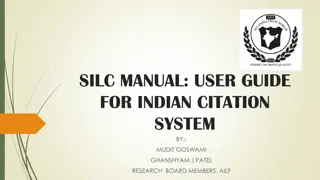Insights on Negotiation Strategies and Tactics
Explore various perspectives on negotiation from renowned authors such as Schelling, Fisher, Ury, Bazerman, Neale, and Mnookin. Discover the importance of bargaining power, the risks of locking into positions, the barriers to creative problem-solving, and the incentives for adversarial tactics. Learn how to navigate negotiations effectively to create value and reach mutually beneficial agreements.
- Negotiation Strategies
- Bargaining Power
- Creative Problem-Solving
- Effective Communication
- Value Creation
Download Presentation

Please find below an Image/Link to download the presentation.
The content on the website is provided AS IS for your information and personal use only. It may not be sold, licensed, or shared on other websites without obtaining consent from the author. Download presentation by click this link. If you encounter any issues during the download, it is possible that the publisher has removed the file from their server.
E N D
Presentation Transcript
Legal Negotiations Summer 2015
Grades: Preparation & Professionalism = 15% Class Performance* = up to 5% of total grade Final Exam = 30 points 1stScored Negotiation = 20% 2ndScored Negotiation = 30%
Some Initial Thoughts on Negotiation in Nelken s Understanding Negotiation (2001), Schelling states that bargaining power has been described as the power to fool and bluff, the ability to set the best price for yourself and fool the other man into thinking this was your maximum offer (p. 77).
More thoughts on Negotiation Fisher and Ury (1981) say it very well: When negotiators bargain over positions, they tend to lock themselves into those positions. The more you clarify your position and defend it against attack, the more committed you become to it. The more you try to convince the other side of the impossibility of changing your opening position, the more difficult it becomes to do so. You now have new interest in saving face in reconciling future action with past positions making it less and less likely that any agreement will wisely reconcile the parties original positions (p. 5).
More thoughts on Negotiation Bazerman and Neale (1992) state that people fail to solve problems because of the assumptions they place on them and that this is the most critical barrier to creative problem solving (p. 18).
More thoughts on Negotiation Mnookin, Peppet and Tulumello (2000) addressed this question directly. Given a choice, most of us clearly would choose to do good. So why don t we? The answer is often something along the lines of The system won t allow it. People place the blame on the culture of law firms, the adversarial nature of our judicial system, the temptation to act out of self-interest, the rewards of playing hardball, the inflated expectations of clients, and the constraints of bargaining in the shadow of the law. The incentives to act combatively, selfishly, or inefficiently can be compelling. As we all know, however, the costs of adversarial tactics can be ruinous And opportunities to create value to make both sides better off slip away (p. 3).
And, one more thought on Negotiation How can I help you get what you want so I can get more of what I want?
Negotiation Ethics Restatement (Second) of Torts 525 Restatement (Second) of Contracts 164 Restatement (Second) of Agency 348 ABA, Model Rules of Professional Conduct Rule 4.1
Negotiation Terminology ZOPA zone of potential agreement BATNA best alternative to a negotiated agreement Aspiration Value the best possible deal available to your client Reservation Value the worst possible deal you could take and still meet your client s interest
Determining Your Clients Interests 1. Essential: what must be obtained 2. Important: what your client wants to get but would willing to exchange for an essential or another Important Item that is higher on the priority list. 3. Desirable: secondary items your client would be happy to get but they would also happily exchange one or more of these for an Important or Essential item.
Negotiation Rule of Thumb 1. Meet your client s interests at the highest level possible. 2. Meet the opposing party s interests well- enough so they will perform. 3. Meet the public s interests in such a way that they will not interfere with your deal.
Cooperative/Problem-Solving Style Move psychologically toward their opponent Try to maximize joint returns Begin with realistic opening offers Seek reasonable results Behave in a courteous and sincere manner Rely on objective standards to guide discussions Rarely resort to threats Maximize the disclosure of relevant information Are open and trusting Are willing to make unilateral concessions
Competitive/Adversarial Style Move psychologically against their opponent Try to maximize their own returns Begin with unrealistic opening offers Seek extreme results Behave in an adversarial and insincere manner Focus primarily on their own positions Frequently resort to threats Minimize the disclosure of their own information Manipulate their opponent.
SinglePart v. LargeCorp Rankings Student Aida, Kenneth Ariana, Marie, Sam Josh, Aeree Brittany, Armin Jennifer, Ammaar Richard Rank 1 2 3 4 5 6
Stages of Negotiation Preparation (Establishing Limits and Goals) Preliminary Stage (Building Rapport) Information Stage (Determining Value & Interests) Distributive/Closing/Cooperative Stage
Stages of Negotiation - Preparation Best Alternative to a Negotiated Agreement Your Client s Interests Opposing Party s Projected Interests Strategy
Stages of Negotiation - Preliminary Starting negotiations with a positive mood: Increases cooperation Produces more agreements Promotes problem-solving to maximize win/win
Stages of Negotiation - Information Listening Asking questions: Open-ended (who, what, when where, how, etc.) Clean questions (what is important about) Blocking techniques (be careful)
Stages of Negotiation - Distributive/Closing/Cooperative Stage Principled Concessions (why) Logrolling/bundling (don t give it away, sell it) Power bargaining Creating value Remember your walk-away point
Determining Your Clients Interests Keys Ask lots of questions, especially clean questions and clarifying questions Research Listen closely Make sure your own deep structure is not driving the bus. The same process applies to determining the other party s interests.
Surface Structure is Words Tonality Body Language Gestures What you observe
Deep Structure is Words Tonality Body Language Gestures Beliefs Values Biases Prejudices Experiences Fears Dreams Feelings
Words Tonality Body Language Gestures Words Tonality Body Language Gestures Beliefs Values Biases Prejudices Experiences Fears Dreams Feelings Beliefs Values Biases Prejudices Experiences Fears Dreams Feelings
International Negotiations Female Male Relationship African African Family French American (4) Business Partners UK Lebanese Work Colleagues UAE Italian (2) Work Colleagues** Lebanese Indian Married (2) Russian Mexican Engaged (2) Brazilian Costa Rican Boyfriend/Girlfriend Indian Russian Affair Costa Rican Old Classmates Mexican Employer Argentinian Italian
To Effectively Negotiate, you must: Prepare. Know your client s interests AND their priorities. Have a thorough understanding of your BATNA. Use techniques even ones you may not be completely comfortable with. Be able to justify your position and make the other party do the same. Watch for blind spots. Prepare.
Bargaining from a Weak Position? Prepare, prepare, prepare. Make sure you are very clear about your Reservation Point, your BATNA, etc. Use your weakness to create value If you push me too hard, you ll destroy me and lose a value-creating partner . Get an expert.























